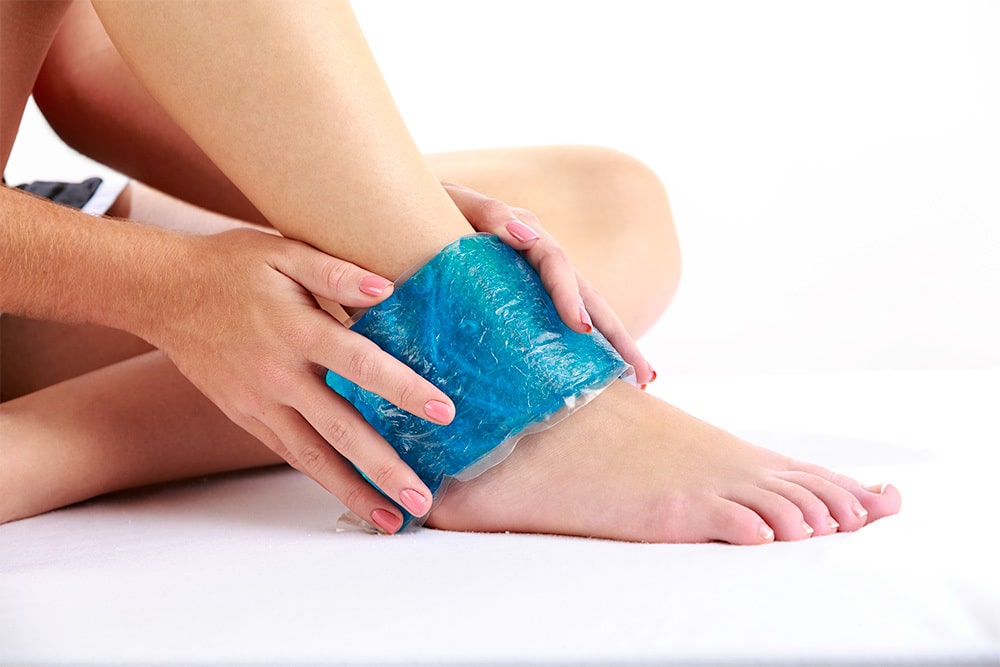When sprains, muscle strains, inflammation, and general pain come at you, knowing exactly when to use ice or heat to treat injury can significantly shorten your recovery.
So what do you choose, ice or heat?
This is a common question asked by patients of their physical therapists during initial evaluations. Many times, the patient has tried one or the other but was unsure which option would benefit them the most. Knowing the benefits of when to use ice or heat to treat injury and the proper duration can help patients manage injuries from the start and speed up the recovery process.

When Ice Should Be Used:
Ankle sprains, acute or chronic pain, acute or subacute inflammation, bursitis, muscle spasms, abnormal tone, tendonitis, musculoskeletal trauma, myofascial trigger, and tenosynovitis.
How Applying Ice Works for an Injury
Ice helps decrease the tissue’s local temperature, resulting in decreased blood flow, edema, and muscle tone. It is also shown to slow metabolic rate and nerve conduction velocity. It can also help increase the body’s pain threshold. Ice should be applied for 15-20 minutes at a time. You should give your tissue adequate time to return to normal temperature between icing sessions.
Exactly how long and how often a patient should ice an injury depends on a variety of factors that a physical therapist can assess, but generally, for the first 72 hours after an injury, it can be iced at least 3 times per day. After 72 hours, some people will respond better to heat, and they can try using heat to alleviate pain and promote healing. Some potential reasons ice might NOT be a great option for you include cold intolerance, cold urticaria, cryoglobulinemia, infection, over-retinaerating peripheral nerves, or any form of vascularization problems (such as PVD or Raynaud’s).

How Applying Heat Works for an Injury
The heat helps increase the local temperature of the injured tissue, resulting in the following:
- Increased blood flow to the area
- Increased capillary permeability
- Increased collagen extensibility
- Increased metabolic rate
- Increased muscle elasticity
- Increased nerve conduction velocity
- Increased pain threshold
Hot packs should be applied for 15‐20 minutes at a time. When applying heat, be sure to protect yourself from direct contact with the heating source. Wrapping it with a towel to prevent burns, and make sure not to fall asleep on a heating pad. Generally, heat should be applied 1-3 times a day. However, if heat is added too early, it can perpetuate the inflammation cycle and harm the body. Possible reasons you should NOT use heat following an injury include acute muscle trauma, arterial disease, bleeding or hemorrhage over the cancerous area, peripheral vascular disease, or thrombophlebitis.

5 Easy-To-Remember Rules for Ice or Heat When Treating an Injury
- If the injury is new and has occurred within the last 3 days = Ice
- If there is noticeable swelling = Ice
- If you have no significant swelling and decreased range of motion = Heat
- If you have increased muscle tightness, spasms, or trouble relaxing muscles = Heat
- If you have had pain for an extended period of time with no range of motion loss and significant swelling. Ice first, then Heat.
Ultimately, the decision to use heat or ice is up to you. Your body might respond differently to heat or ice, so try different variations of both treatments to determine which ones you find most effective. If you have recently been injured and are dealing with pain, a physical therapist can evaluate you and help you to determine an appropriate course of action for treatment. Contact your local Foothills Sports Medicine’s Physical Therapy clinic today for a free injury assessment or if you have questions about pain management!




